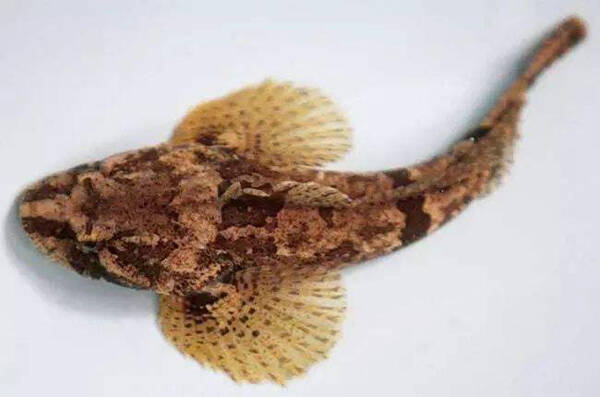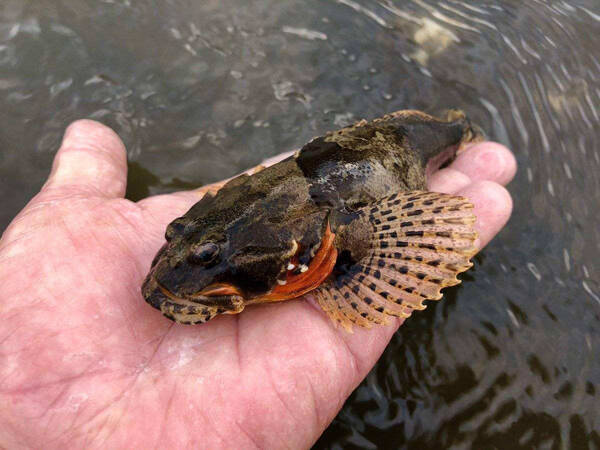Songjiang perch (scientific name: Trachidermus fasciatus) is a fish of the family Sculpinidae and the genus Trachidermus, with no subspecies.

Because the production of Songjiang near the mouth of the Yangtze River in China is relatively high and the body is relatively black, it is named Songjiang perch. It was first seen in Fan Ye's "Book of the Later Han Dynasty·Biography of Zuo Ci", which recorded Cao Cao's banquet saying: "Today is a grand gathering, and the delicacies are a little prepared, but the Songjiang perch is missing." The gill membrane has orange-red banded spots that resemble gill holes. It is also called four-gill perch, flower daughter-in-law and flower drum fish.
Songjiang perch is a warm-temperate bottom migratory fish in the nearshore area. It lives in shallow waters along the coast and rivers and lakes connected to the sea. It has the habit of migrating to the river, growing and fattening in fresh water, and breeding in the estuary and near the sea. From April to November, it lives in juveniles and adults in fresh water. It often lives in places with micro-flowing water, clear water, rich bait organisms, deep water and hidden objects. The time when adult fish descend to the river is closely related to the local temperature and water temperature. In the Yangtze River Delta, it usually starts from the end of November to the beginning of February of the following year. Young fish start migrating from late April to early to mid-June, with May being the peak period for migrating. Songjiang perch lives on the bottom of the river, hiding during the day and coming out at night. It is a carnivorous fish that feeds on protozoa, rotifers, cladocerans, copepods, aquatic insects, benthic animals, shrimps and fish. Individuals with a body length of less than 40 mm mainly feed on cladocerans; individuals with a body length of 40 to 70 mm feed on small shrimps in addition to cladocerans; individuals with a body length of more than 70 mm mainly feed on shrimps, and also feed on small fish such as gobies, club fish and wheat ear fish. They do not feed during the reproductive period.
Songjiang perch has a strong adaptability to temperature and salinity in the natural environment. Adult fish can survive in water temperatures of 0°C. The optimal temperature for reproduction is 4 to 14°C. Songjiang perch can live and reproduce in seawater with a salinity of 30-32‰, and can grow, develop and fatten in low-salinity water and fresh water. In the later growth, it needs water conditions with low salinity and trace iodine.

The oyster tooth reef in the southern Yellow Sea of China is a spawning ground for Songjiang perch. Any shallow intertidal area along the coast with suitable salinity and certain attachments may have its spawning grounds. The egg carrying capacity is usually 5100 to 12800 eggs. Parents have the habit of guarding the nest and protecting the eggs. After laying eggs, the female fish leaves first, and the male fish stays in the nest to protect the eggs. During the egg protection period, if there is an enemy, the guarding male fish will fight with it. The breeding period is from mid-February to mid-March. The eggs are sticky, with a diameter of 1.48 to 1.58 mm and oil balls. The eggs can be fertilized and developed in seawater with a salinity of 5 to 16 and artificially prepared seawater. The fertilized eggs are in clumps and attached to the empty shells of clams or gravel for incubation. The incubation period is relatively long, and it takes 26 days when the water temperature is 14°C.
The fish that migrate to the river for reproduction must be in a certain salinity to promote the gonads to reach sexual maturity. When Songjiang perch and other fish live in fresh water, the prolactin secretion area of the anterior pituitary is relatively developed, while the gonadotropin secretion area of the main part of the anterior lobe is relatively small. Prolactin is related to osmotic pressure regulation. The increase in prolactin secretion inhibits the secretion of gonadotropin, thus causing these fish to be infertile in fresh water. When they enter seawater, the gonadotropin secretion area of the pituitary gland is significantly enlarged, while the prolactin secretion area is reduced. Sea-dwelling fish need a large amount of thyroid hormone when their gonads grow and reproduce, and the iodine content in freshwater is not as high as that in seawater, which cannot meet the needs of synthesizing thyroid hormone when the thyroid function is vigorous. Therefore, when artificially breeding sea-dwelling fish, they must be gradually transitioned to living in seawater to achieve satisfactory results.
Songjiang perch is a second-class protected animal in China and is currently prohibited from being caught. Since the 1970s, with the development of industrial and agricultural production, a large number of water conservancy facilities have been built, which have cut off its migration channel. The number of seedlings entering inland waters for fattening has been greatly reduced, seriously affecting the regeneration and replenishment of resources. At the same time, industrial sewage has increased day by day, and pesticides and fertilizers have been discharged, seriously polluting the water environment and blocking its migration channel. Under this dual influence, natural resources are becoming increasingly exhausted. In order to save this rare fish, relevant research departments have conducted in-depth and extensive research on it and achieved initial results in artificial breeding and artificial stocking.
Listed in the second level of China's "National Key Protected Wildlife List".
Protect wild animals and stop eating game.
Maintaining ecological balance is everyone's responsibility!